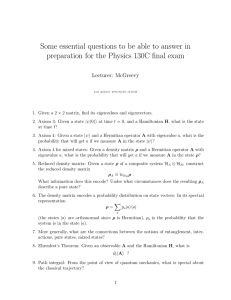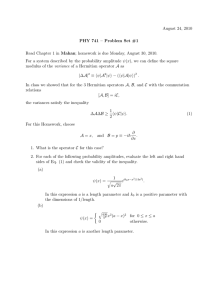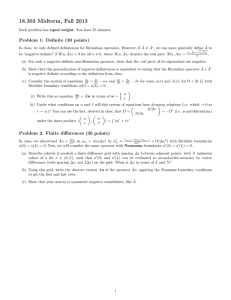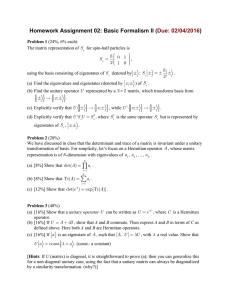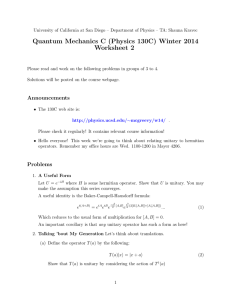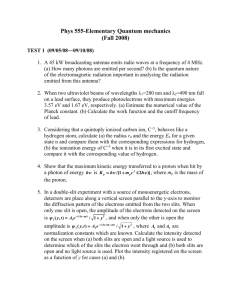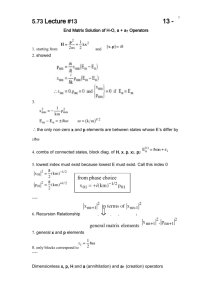Document 13492543
advertisement
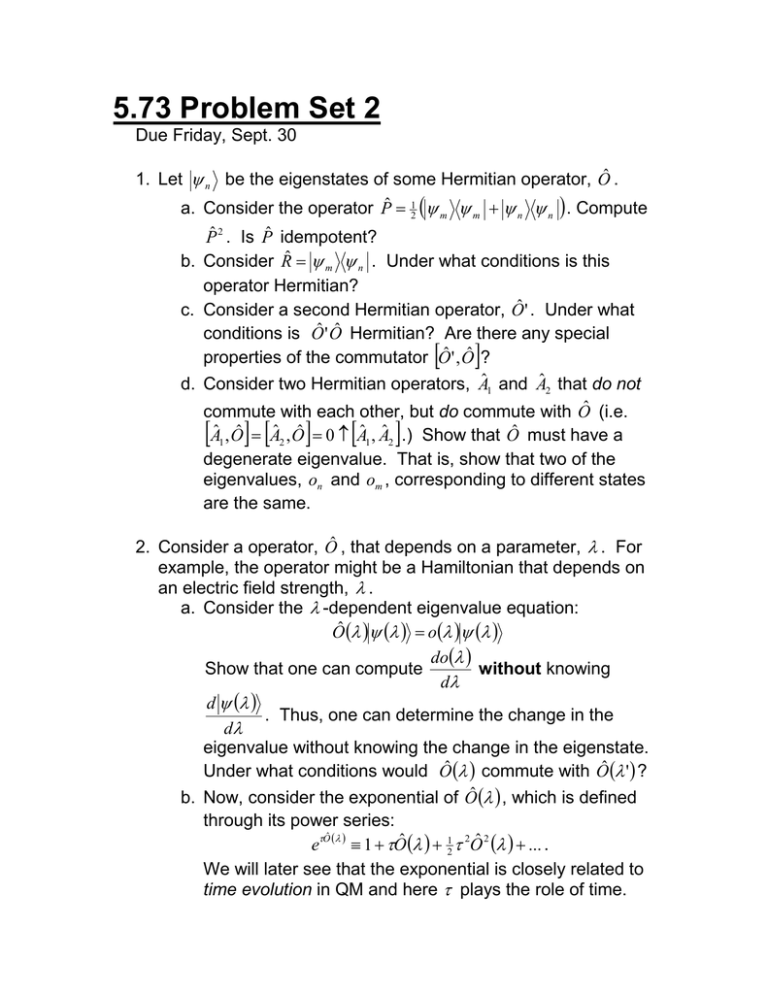
5.73 Problem Set 2 Due Friday, Sept. 30 1. Let ψ n be the eigenstates of some Hermitian operator, Oˆ . a. Consider the operator Pˆ = 12 (ψ m ψ m + ψ n ψ n ) . Compute Pˆ 2 . Is Pˆ idempotent? b. Consider Rˆ = ψ m ψ n . Under what conditions is this operator Hermitian? c. Consider a second Hermitian operator, Oˆ ' . Under what conditions is Oˆ ' Oˆ Hermitian? Are there any special properties of the commutator Oˆ ' , Oˆ ? d. Consider two Hermitian operators, Aˆ1 and Aˆ 2 that do not commute with each other, but do commute with Oˆ (i.e. Aˆ1 , Oˆ = Aˆ 2 , Oˆ = 0 ≠ Aˆ1 , Aˆ 2 .) Show that Oˆ must have a [ [ ] [ ] [ ] ] degenerate eigenvalue. That is, show that two of the eigenvalues, on and om , corresponding to different states are the same. 2. Consider a operator, Oˆ , that depends on a parameter, λ . For example, the operator might be a Hamiltonian that depends on an electric field strength, λ . a. Consider the λ -dependent eigenvalue equation: Oˆ (λ )ψ (λ ) = o(λ )ψ (λ ) do(λ ) Show that one can compute without knowing dλ d ψ (λ ) . Thus, one can determine the change in the dλ eigenvalue without knowing the change in the eigenstate. Under what conditions would Oˆ (λ ) commute with Oˆ (λ ' ) ? b. Now, consider the exponential of Oˆ (λ ) , which is defined through its power series: ˆ eτO (λ ) ≡ 1 + τOˆ (λ ) + 12 τ 2Oˆ 2 (λ ) + ... . We will later see that the exponential is closely related to time evolution in QM and here τ plays the role of time. Show that Oˆ (λ ) commutes with its exponential. That is, ˆ show that Oˆ (λ ), eτO (λ ) = 0 . c. One often wants to compute the derivative of the exponential with respect to the external parameter λ . Show that d τOˆ (λ ) τ αOˆ (λ ) dOˆ (λ ) (τ −α )Oˆ (λ ) e e dα . = ∫e dλ d λ 0 ˆ Do not assume that O (λ ) commutes with dOˆ (λ ) / dλ . [Hint: Show that both sides ( Xˆ ) satisfy the first order differential equation (in τ ): ˆ d Χ dOˆ (λ ) ˆ − Xˆ Oˆ (λ ) = eτO (λ ) dτ dλ Then, if the two sides are equal at τ = 0 , they must be equal for all τ .] [ ] 3. The following concern a diatomic molecule with a simple harmonic potential between the atoms V ( xˆ ) = 12 kxˆ 2 . Assume � = m = 1 and denote the eigenstates of the Hamiltonian by n . a. Find the linear combination of 0 and 1 ( ϕ = a 0 + b 1 ) for which the average value of xˆ is maximum. Repeat this process for a linear combination of 0 and 2 . What are the maximum values possible in each case? Which works better? b. Same as b., but this time maximize the average value of xˆ 2 . What conclusion do you draw from these two calculations? c. Now, assume that the molecule (starting in the vibrational and electronic ground state) is instantaneously promoted to an excited electronic state (say by a laser). In this state the potential felt by the atoms is V ( xˆ ) = 13 kxˆ 2 . What is the average energy of the atoms in the new state? Here, we are making use of the Franck-Condon approximation by assuming the electronic state adjusts much more quickly than the nuclei. 4. For any one dimensional (1D) system, if we turn on a magnetic field of strength B perpendicular to the 1D axis, the resulting 1D Hamiltonian is: Hˆ B = Hˆ + Bpˆ . Assume that we have a harmonic oscillator of frequency ω and we subject it to a perpendicular magnetic field, B . a. What are the observable energies for the system now that the field is on? You should determine these energies analytically (i.e. without assuming a numerical value for B ). b. We make a measurement of the energy and find a particular value En . Next, we measure the momentum. If we perform this sequence of measurements many, many times (i.e. we measure the energy and find En and then measure the momentum) what will be the average outcome? Your expression should be correct for any choice of B , n .[Hint: you should not need any explicit wavefunctions to do this.]
